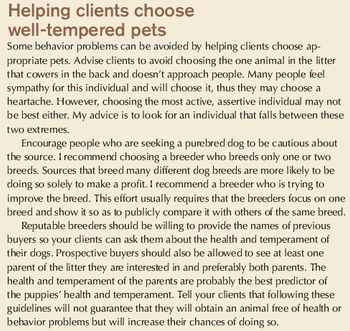
A veterinary visit should be the starting point for each behavior case. The first step would be to rule out any medical factors that might be contributing to the behavioral signs.

A veterinary visit should be the starting point for each behavior case. The first step would be to rule out any medical factors that might be contributing to the behavioral signs.

Many pet owners are misinformed or naive when it comes to understanding the behavioral development and training of pets.

How a dog responds to a stimulus will be based on its genetics, socialisation and previous experience.

Domestication and selective breeding (genetics) may lead to increasingly affectionate, socially dependent and infantilized dogs with excessive owner attachment and intolerance to being left alone.

Inappropriate elimination, both housesoiling and urine spraying (vertical marking) are the most common feline behavior problems seen at behavior referral practices.

In some situations, practitioners are left trying to determine whether an animal's behavioral change reflects a medical issue or a behavioral problem.

Psychotropic drugs and natural alternatives might be used to help reduce the signs associated with phobic, panic or chronic anxiety states and to improve trainability especially in situations where the pet is too anxious, fearful or impulsive to control its responses.

Aggression is the most common reason that dogs are seen at behavior referral practices.

Environmental enrichment is an important and essential aspect of most animal management programs.

Feline housesoiling still represents the most common reason cat owners seek behavioral advice from their veterinarian.

Behavior problems are frustrating, emotionally taxing, and often dangerous to the animal or those around the animal.

A cat may become fearful, anxious or highly aroused in situations that are unpredictable, those that have been previously fear evoking, or when there is a perceived threat.

Behavioral signs such as changes in activity levels, altered responses to stimuli, altered social interactions, anxiety, altered sleep-wake cycles, housesoiling, confusion or memory deficits may arise as a result of brain aging (e.g. cognitive dysfunction syndrome).

Monitoring and assessing behavioral signs is a critical component of every veterinary visit.

Effective restraint is one of those aspects of veterinary medicine that we simultaneously take for granted but also wish we could do better.

There are a variety of behavioral services that should be provided by every veterinary clinic, including pre-selection counseling, preventive counseling, castration and spaying, puppy and kitten classes and obedience training, behavior screening, behavior counseling and the sale of behavior products.

In this article, I discuss 10 common myths about animal, particularly canine, behavior--misconceptions that may increase the likelihood that a pet will develop a behavior problem and, thus, can lead to the pet's abandonment or euthanasia.

Davis, Calif. -- Contrary to historical recommendation, the American Veterinary Society of Animal Behavior (AVSAB) now is taking the position that puppies should begin socialization before all their vaccinations are complete.

Definite personality changes and behavioral problems can be extremely challenging to the practitioner and extremely frustrating to the client.

Virtually all family veterinarians are commonly asked to recommend a breed of dog that is best for a particular client.

Veterinarians are faced with the short life spans of their patients, providing them a large number of aged patients with chronic conditions and requiring special care.

Drugs are not a new aspect of veterinary behavioral medicine, but coming more into the forefront.

The notion that animals benefit human health and wellbeing has become a widespread belief.

Compared with looking for a new puppy for the family, looking for a new kitten is usually quite a different matter.

The veterinary staff sees families at their moments of greatest worry concerning their companion animals.